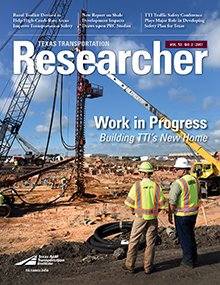In Texas, I-35 stretches some 500 miles, from the Rio Grande to the Red River. Much of I-35 was once known as the Chisholm Trail, and 50 percent of the state’s population — that’s nearly 14 million people — live within 50 miles of I-35 today. No wonder Texans refer to the interstate as Main Street Texas.

In 2008, the Texas Department of Transportation (TxDOT) began its My35 project to improve mobility and safety along the corridor. The focus to date has been to expand and enhance the 96-mile stretch between Hillsboro and Salado, a vital section of the corridor north of Austin traveled daily by 100,000 to 130,000 motorists. For the last seven years, the Texas A&M Transportation Institute (TTI) has provided logistical and technical support to TxDOT in the corridor, including developing a first-of-its-kind traveler information system.
“Our mission was to help TxDOT keep drivers informed during the construction process,” explains Bob Brydia, TTI’s principal investigator on the project. “To accomplish it, we asked three questions: Where are work-zone lane closures, where will travelers be delayed, and what are the current traffic conditions?”
To find the answers, TTI installed Bluetooth® readers, Wavetronix sensors, and end-of-queue warning systems along I-35 and then formulated algorithms to integrate and mine the massive amounts of data gathered. The results are reliable traffic forecasts and regular construction incident reports passed along as driver alerts delivered via various media.
“A real success story of this project is how effectively we’ve been able to interface with TxDOT’s LoneStar traffic management system,” Brydia explains. “We feed our information to TxDOT, and that helps drive the messages you see along the roadway.”

Brydia is referring to the permanent dynamic message signs now installed in the corridor that provide real-time travel estimates for (and the distance to) upcoming towns, and that warn drivers of slowdowns and accidents ahead. Travelers, local residents and business owners can also receive construction updates via text message, Twitter, web and email. Whether it’s parents looking for the best route to take their children to school or EMS personnel racing to the scene of a traffic incident, the alerts can help them make the best routing decision needed — and sometimes that makes the difference between life and death.
“Understanding that different audiences need the same information for different reasons was vitally important to us,” says John Habermann, TTI’s lead mobility coordinator on the project. “Anyone who uses the corridor — whether they’re just passing through, reside in the area, or operate one of the 1,000 businesses along that stretch of I-35 — can benefit from the system.”
Brydia and his team have actively sought user input via surveys conducted throughout the life of the project. Respondents helped to shape the kind of information travelers receive and how they get it. For example, in 2012, the TTI team used feedback from more than 900 respondents to create the initial version of what Brydia calls the “most advanced, robust construction lane-closure database in the nation.” Regular updates continue refining messages and how they’re communicated. And underlying the system’s usefulness is all that data gathered daily as hundreds of thousands of drivers travel along I-35.

Using data parsed by TTI’s algorithms, the map generates, in real time, reports specifically requested by survey respondents, such as expected points of delay during construction, current travel times, incident locations and detour options. In April 2017 alone, more than 21,000 travelers used the map to plan their trips. And when reliable routes matter most — say, during a natural disaster — having mapped alternate routes can help keep travelers safe.
Once construction in TxDOT’s Waco District is finished, the equipment generating the traveler information will stay online as a permanent enhancement to the smart corridor I-35 is becoming. The Austin District recently embarked on the Mobility 35 project, a $4.1 billion effort to extend the benefits of expansion to another section of I-35.
“TxDOT wants to be as responsive and helpful as we can to our fellow Texans during the reconstruction process,” says Jodi Wheatley, TxDOT’s I-35 public information officer. “That would be much more difficult without TTI’s Traveler Information System. The Institute’s expertise has made I-35 construction in the Waco District safer, easier to negotiate, and more predictable for travelers.”

